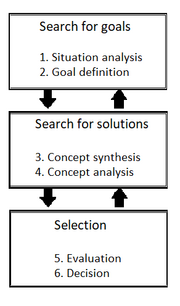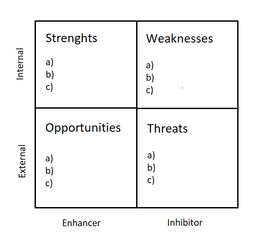SWOT Analysis
| Line 4: | Line 4: | ||
== Description of the Tool == | == Description of the Tool == | ||
| − | [[File:PSC.png|thumb|right|upright= | + | [[File:PSC.png|thumb|right|upright=1|Figure1: Problem-Solving Cycle as a recursive procedure <ref name=NMMT/>''.]] |
=== The Role of SWOT in Project, Program and Portfolio Management === | === The Role of SWOT in Project, Program and Portfolio Management === | ||
| Line 18: | Line 18: | ||
These steps are not definite. In fact, the later steps can have effects on the earlier steps and reassessments may be necessary.<ref name=NMMT/> | These steps are not definite. In fact, the later steps can have effects on the earlier steps and reassessments may be necessary.<ref name=NMMT/> | ||
| − | A core question during the situation analysis is ''"What do we want to achieve?"''<ref name=NMMT/> To successfully aim at the desired future state, it is necessary to take all uncertainties into account. SWOT helps project, program and portfolio managers to systematically consider these uncertainties and to anticipate changes in the environment surrounding the project, program or portfolio.<ref name=NMMT/> By executing a SWOT analysis a better prediction of future developments is possible and great knowledge of the situation is gained. | + | A core question during the situation analysis is ''"What do we want to achieve?"''<ref name=NMMT/> To successfully aim at the desired future state, it is necessary to take all uncertainties into account. SWOT helps project, program and portfolio managers to systematically consider these uncertainties and to anticipate changes in the environment surrounding the project, program or portfolio.<ref name=NMMT/> By executing a SWOT analysis a better prediction of external factors and future developments is possible and great knowledge of internal factors and the situation is gained. This makes it a powerful tool for the first step in the Problem Solving Cycle. |
| − | + | ||
---- | ---- | ||
| − | |||
=== Conventional SWOT Analysis === | === Conventional SWOT Analysis === | ||
| + | [[File:Conventional SWOT Matrix.png|thumb|right|upright=1.5|Figure2: Conventional SWOT Matrix <ref name=HBOIP/>''.]] | ||
SWOT can be executed in different ways, but they all share the view on internal and external enhancers and inhibitors of organizational performance.<ref name=HBOIP/> At the beginning of the analysis, strengths and weaknesses of the specific organization, project or the whole business area are identified. The next step is detecting which opportunities and which threats result from this.<ref name=PMBOK/> | SWOT can be executed in different ways, but they all share the view on internal and external enhancers and inhibitors of organizational performance.<ref name=HBOIP/> At the beginning of the analysis, strengths and weaknesses of the specific organization, project or the whole business area are identified. The next step is detecting which opportunities and which threats result from this.<ref name=PMBOK/> | ||
Claire Capon, Professor of the Staffordshire University; defines the four dimensions of the analysis as follows: | Claire Capon, Professor of the Staffordshire University; defines the four dimensions of the analysis as follows: | ||
| Line 52: | Line 51: | ||
== Application == | == Application == | ||
| − | * | + | SWOT is used on many occasions. Three situations, in which the method particularly applicable are shown below: |
| − | * | + | |
| + | * When analyzing performance. The effects of the internal and external dimensions are being surveyed and how they have an influence on the output of the group. The effectiveness of the group could be another dimension of the survey. | ||
| + | |||
| + | * When executing cause analysis. SWOT can examine which practices, tools or methods should still be used in the future and which should be dropped. | ||
| + | |||
| + | * As a part of a continuous improvement process, by regularly checking and updating the strengths, weaknesses, opportunities and strengths when new influences arise. | ||
== Discussion and Limitations== | == Discussion and Limitations== | ||
Revision as of 18:02, 20 February 2021
Developed by Henning Duwe
SWOT is a commonly used method that helps to systematically analyze a topic by dividing it into the four categories “Strengths”, “Weaknesses”, “Opportunities” and “Threats” to examine their influence [1] and how these attributes interact with each other. It can be described as a planning technique for Situation [2] or Data Analysis [3]or as a tool for “identifying, relating, and making performance improvement decisions within context.”[1] The results can then be used as a foundation to formulate goals and to search for solutions.[2]
Contents |
Description of the Tool

The Role of SWOT in Project, Program and Portfolio Management
Due to its basal approach to analyze a problem, SWOT can be used in various applications. In terms of Project, Program and Portfolio Management it is commonly used in the planning process to analyze the future situation of the Project, Program or Portfolio with its strengths, weaknesses, opportunities and threats. Being a method for situation analysis, it is used at the beginning of the Problem Solving Cycle (PSC).[2]
The PSC is a procedure that aims to solve problems and create the best possible solution. According to Rainer Züst and Peter Troxler it can be divided into three major and six minor steps (see figure 1):
- The search for goals, consisting of the situation analysis and the goal definition,
- the search for solutions, consisting of the concept synthesis and concept analysis and
- the selection, consisting of the evaluation and decision.[2]
These steps are not definite. In fact, the later steps can have effects on the earlier steps and reassessments may be necessary.[2]
A core question during the situation analysis is "What do we want to achieve?"[2] To successfully aim at the desired future state, it is necessary to take all uncertainties into account. SWOT helps project, program and portfolio managers to systematically consider these uncertainties and to anticipate changes in the environment surrounding the project, program or portfolio.[2] By executing a SWOT analysis a better prediction of external factors and future developments is possible and great knowledge of internal factors and the situation is gained. This makes it a powerful tool for the first step in the Problem Solving Cycle.
Conventional SWOT Analysis

SWOT can be executed in different ways, but they all share the view on internal and external enhancers and inhibitors of organizational performance.[1] At the beginning of the analysis, strengths and weaknesses of the specific organization, project or the whole business area are identified. The next step is detecting which opportunities and which threats result from this.[3] Claire Capon, Professor of the Staffordshire University; defines the four dimensions of the analysis as follows:
- Strength: an internal enhancer of competence, a valuable resource, or attribute
- Weakness: an internal inhibitor of the competence, resources, or attributes necessary for success
- Opportunity: an external enhancer of performance that can be pursued or exploited to gain benefit
- Threat: an external inhibitor of performance that has the potential to reduce accomplishments [1]
The SWOT-Analysis is often being executed without examining the interdependencies between these attributes.[1] Still, in this “Conventional SWOT” the two dimensions “Strengths” and “Weaknesses” are categorized as internal factors and “Opportunities” and “Threats” as external factors. For the SWOT, a 2-by-2 matrix is commonly used as a structure (see figure 2).
The advantages of this simplified analysis are that each factor can be examined individually with still having a holistic view on the matter. Additionally, this way of executing SWOT is faster and easier.[1] On the other hand, the analysis is less broad and deep and the interdependencies and synergies are getting ignored.
Advanced SWOT Analysis
The original SWOT analysis structures the different causes of the strengths, weaknesses etc. especially due to their urgency for action.[2] But it also examines to which degree the strengths of the organization could offset the threats and determines if the weaknesses possibly restrain the opportunities.[3]
Strengths, Weaknesses, Opportunities and Threats which have the same cause can be put into groups since they probably need the same or similar actions. For each of the four fields in the matrix a basic approach can be defined:
- Strengths/opportunities: build on strengths and use opportunities
- Strengths/threats: build on strengths and minimalize threats
- Weaknesses/opportunities: repair weaknesses and use opportunities
- Weaknesses/threats: repair weaknesses and minimalize threats[2]
For each of these segments, an own evaluation is made. The ultimate goal is to have an overview of the issue from the most important perspectives and therefore have a basis for upcoming decisions under uncertainty. One of the strengths of SWOT is that it raises attention to the context, in which the results of the decision will be implemented. In a traditional SWOT analysis, contextual factors like an increasing market fragmentation categorized as a threat are classified and discussed by the participants. By doing so, a better understanding of the context can be accomplished. [1]
Application
SWOT is used on many occasions. Three situations, in which the method particularly applicable are shown below:
- When analyzing performance. The effects of the internal and external dimensions are being surveyed and how they have an influence on the output of the group. The effectiveness of the group could be another dimension of the survey.
- When executing cause analysis. SWOT can examine which practices, tools or methods should still be used in the future and which should be dropped.
- As a part of a continuous improvement process, by regularly checking and updating the strengths, weaknesses, opportunities and strengths when new influences arise.
Discussion and Limitations
- External vs internal
- Prioritization of the SWOTs
- What can it do, what can it not do?
Annotated Bibliography
References
- ↑ 1.0 1.1 1.2 1.3 1.4 1.5 1.6 1.7 Watkins, Ryan and Leigh, Doug. Handbook of Improving Performance in the Workplace, 2010. Pfeiffer.
- ↑ 2.0 2.1 2.2 2.3 2.4 2.5 2.6 2.7 2.8 2.9 Zuest, Rainer and Troxler, Peter. No More Muddling Through, 2006. Springer.
- ↑ 3.0 3.1 3.2 Zuest, Project Management Institute. Guide to the Project Management Body of Knowledge, 2017. Project Management Institute.